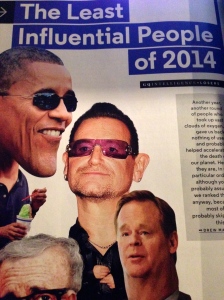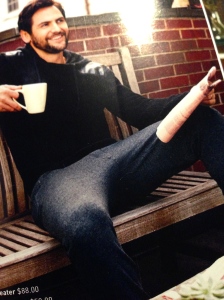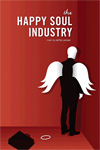Why hasn’t fashion advertising come to grips with our massive addiction to technology?
September 19, 2014

She’s surprisingly hard to find…
In the latest issue of GQ are hundreds of fashion ads featuring hip, trendy people and not one of them is interacting with a smart phone or tablet. And yet, in reality that’s all these people do. I was taken by this dichotomy between the idealized world and the real world.
If technology is so NOW then why isn’t it conceptually a part of these ads targeting the very people who most want to be seen as hip, sexy and cool? I Tweeted the question and wasn’t surprised by the interest it created. There’s something very telling going on here. But what exactly?
Here’s my theory. It’s simple but also unsettling. Despite (or because of) our addiction to smart phones and computing, we don’t want to see ourselves that way. At least not through the mirror of advertising. GQ has page after page of young, beautiful people NOT interacting with technology. Instead they are rowing boats, camping, driving convertibles, kissing… In other words, doing all the things we aspired to do before we fell into our iPhones.
Walk down Chicago’s Magnificent Mile or NYC’s 5th Avenue and what do you see? Real versions of these same people tethered to ear buds, faces buried in their smart phones. Girls walking and texting is so rampant they should put up signs.
I’m no exception. I spend so much time at my computer it causes family problems. Seeing all these fashion-y people not on their computers was like an epiphany. We are still in denial about our addiction to technology.
Fashion advertising sans gadgets: Could it be we’re in denial about our addiction to technology?
September 2, 2011

Beautiful… But not GQ beautiful.
In the September issue of GQ there are hundreds of fashion ads featuring hip, trendy people and not one of them is interacting with a smart phone or PC. And yet, in the reality that’s all these people do. I was taken by this dichotomy between the idealized world and the real world.
If technology is so NOW then why isn’t it conceptually a part of these ads targeting the very people who most want to be hip, sexy and cool? I Tweeted the question and wasn’t surprised by how much interest it created. There’s something very telling going on here. But what exactly?
Here’s my theory. It’s simple but it’s also unsettling. Despite (or precisely because of) our addiction to smart phones and computing, we don’t want to see ourselves that way. At least not according to GQ. Nope. The magazine has page after page of young, beautiful people NOT interacting with technology. Instead they are rowing boats, camping, driving convertibles, kissing…In other words, doing all the things we aspired to do before we fell into our iPhones.
Walk down Chicago’s Magnificent Mile or NYC’s 5th Avenue and what do you see? Real versions of these same people tethered to ear buds, faces buried in their smart phones. Girls walking and texting is so rampant they should put up signs.
I’m no exception I spend so much time at my computer it has caused marital problems! Yet, the addiction didn’t phase me until I saw all those pages of people not on their computers. It was like an epiphany. We are not only addicted to our machines but we are in denial about it as well!
The Letter from the Editor which heads up the May issue of GQ has little to do with advertising but certainly qualifies as a nasty morsel of popular culture. It’s also quite sad. The magazine’s Editor-in-Chief, Jim Nelson was dining at the famed New Orleans’ restaurant, Stella this past Mardi Gras and happened to be in “wine spitting” distance of Nicolas Cage while he was in the midst of a notorious alcohol-induced blackout. Most of us are familiar with Cage’s meltdown, having heard the story here there and everywhere. Likely, we all attributed it to another “moment” in the controversial and bizarre star’s repertoire. Known for playing myriad odd, terrible and often wonderful characters (Raising Arizona, Vampire’s Kiss, Ghost Rider, Bad Lieutenant: Port of Call New Orleans, among many others), here he seemed to be channeling Charlie Sheen and then some.

“Leaving Las Vegas” no longer an act.
In any event, the GQ editor witnessed the entire debacle and elected to make it the subject of his forward to the magazine. Wise choice. As I said, it’s a scintillating piece.
But as I also said, it’s a sad one. But sadness is not the tone Nelson reported. Like most observers of popular culture, he took aim at the falling star and gave us a blow by blow. I don’t begrudge the writer for doing so. That’s his job. Sort of.
But there’s a crucial piece missing from the tawdry tale that might have actually provided real learning to the reader. In describing Cage’s condition, I intended the word “blackout” as noun more than adjective. Nicolas Cage was having an alcoholic blackout. In this condition the man no longer is cognizant, let alone in control. The symptoms were textbook. Yet, I’ll bet many of you are only aware of the obvious ones: lewdness, lechery and violence. Those lovely defects are what got Mr. Cage arrested, no small feat during Mardi Gras.
But what I found eerily fascinating were some of the other defects Cage manifested during his downward spiral. Nelson reports that the actor had befriended a couple at the bar and had insisted on buying them drinks. And not just any drinks but some of the most expensive wines on Stella’s impressive list. In recovery programs, they call this “grandiosity.” You say Cage is a millionaire movie star (actually, he’s bankrupt) but I’m telling you even garden variety drunks can and do display this defect. All of the time. It’s a marker for alcoholism.
Poignantly, prior to his arrest (just after breaking an interior window), Cage bellows to the embarrassed crowd: “You love me!” I say poignantly because now his grandiosity has degraded into self-pity and self-destruction. As Nelson pointed out in his article, chances are many of the patrons did, in fact, once love him, or at least got a kick out of him. But not anymore. Now they merely wanted him gone. Nicolas cage had hit a “bottom,” another recovery term that requires no defining. For Cage, that meant oblivion and a jail cell, not necessarily in that order.

Call it what it is: Alcoholism
Look, I don’t pretend to really care about Nicolas Cage or his personal demons. However, I do feel that every once in a while, when we’re given these all-too-similar stories about falling stars (Charlie Sheen, Lindsay Lohan, Courtney Love, etc…), that we are given the full story. It justifies none of their behavior but it might help someone else understand what’s going on or maybe even get better (themselves), if they’re sick, like Nicolas Cage clearly was and is. By not doing so, I feel the media (and society as a whole) is in as much denial about alcoholism and addiction at the pour souls they are covering.
Black Tie. Otherwise known as the outer ring of Hell.
September 27, 2010
This weekend I attended the Harvest Ball, in support of the Botanical Gardens in Glencoe, Illinois. It was a black tie affair and so, reluctantly, I unzipped my tuxedo from its black envelope in the closet. I don’t know about you but I just don’t care for playing dress up even for a good cause. Maybe it’s a guy thing. My wife spent half the day at the beauty salon and enjoyed every costly moment of it. To me spending a Saturday afternoon in a tricked-out downtown basement getting dolled up sounds like Hell, perhaps not its burning, miserable core but certainly an outer ring. My wife scoffs at me for suggesting as much. You’re getting pampered, she says. There’s camaraderie, gossip; it’s a wonderful experience. It better be. I think about the hundreds of dollars it all probably costs, not including tips.
Needless to say, I don’t do any of that stuff. I shave and shower and get dressed. The only real difference is getting dressed. Oh, but what a difference! Instead of choosing a pair of pants and a shirt now I must go through a complicated process not unlike assembling a bicycle on Christmas morning.
Where to begin? Let’s go right to the worst part: putting on cuff links. Part of my struggle here is due to my own ignorance. For twenty years I tried to put them on after I’d put on my shirt –truly the definition of frustrating. Flipping the order solved that problem but I still fumble and bumble and invariably get it wrong.
The reason I didn’t start with every man’s nightmare, the dreaded bow tie, is because I don’t even go there. Clip on ties are acceptable to more and more people and thankfully my wife is one of them. Many moons ago I tried tying a bow tie and, after an hour of agonizing failure, I had to ask another man to do it. Oh, the humility! Never again.
Then there’s the tux itself. Either too tight or too loose, it’s never the right size. This is because I haven’t worn the damn thing in at least a year. Regardless of which scenario, an ill-fitting tux makes me feel like an awkward teenager. When my wife tells me I look handsome she sounds like my mother.
Disdaining patent leather slip-ons –they look and feel like ballet slippers- I now wear a nice pair of black boots. I don’t know if this is acceptable and I don’t care.
I know some men get a kick out of black tie. I read Details and GQ. I enjoy a nice cashmere sweater and sporting a sharp tie once in a while. I also like the look, smell and feel of $500 dollar shoes. I just draw a line at black tie.
I recognize it works for James Bond, George Clooney and old rich guys getting in limos on Park Avenue. I can live with the fact that I ain’t one of them. For years I never gave my sartorial deficiency a second thought. Not difficult given the relaxed dress in most creative departments. But along comes Mad Men and suddenly advertising is fashionable. As is drinking. Even smashed the characters look smashing. Hmmm. I’d love to see Don Draper tie on a bow after tying one on.









 The Happy Soul Industry
The Happy Soul Industry The Last Generation
The Last Generation